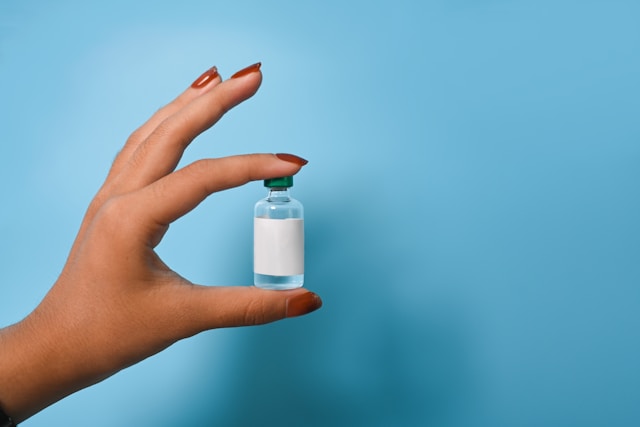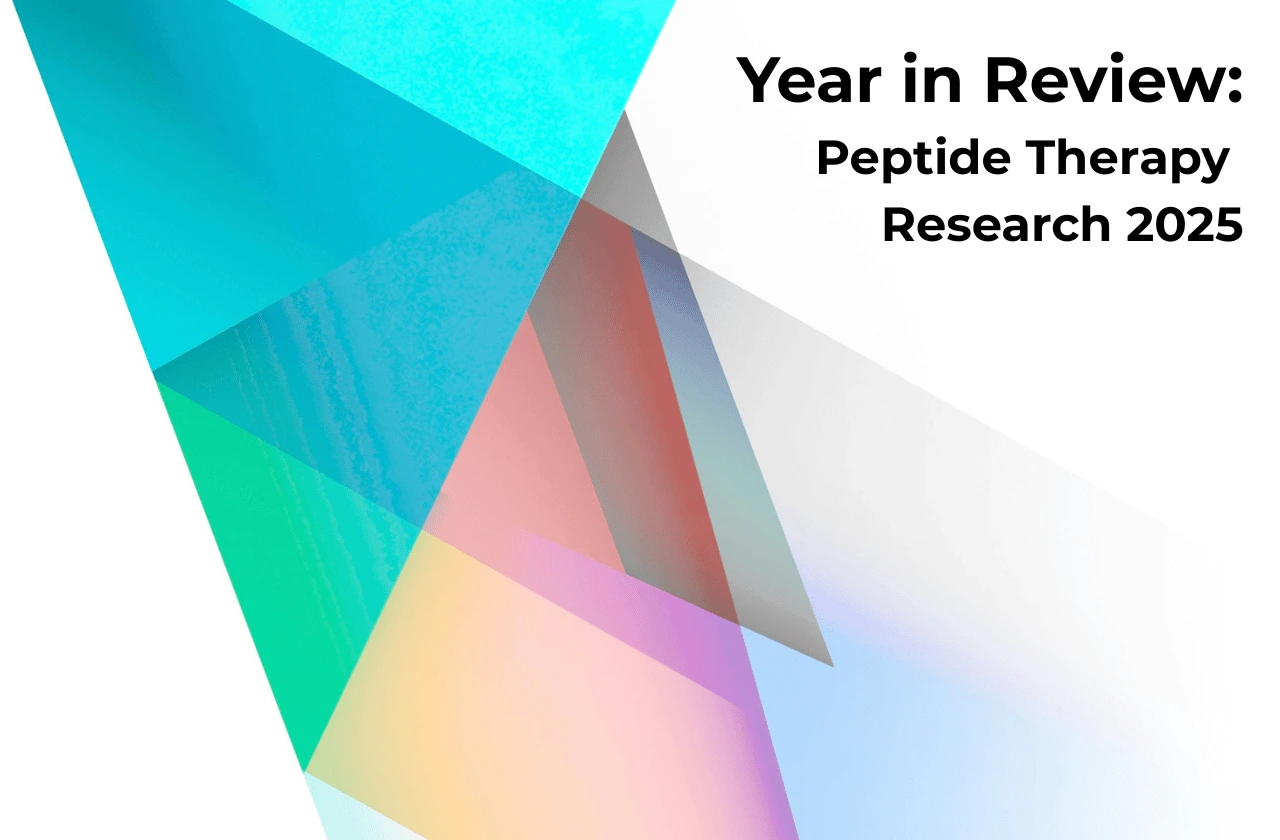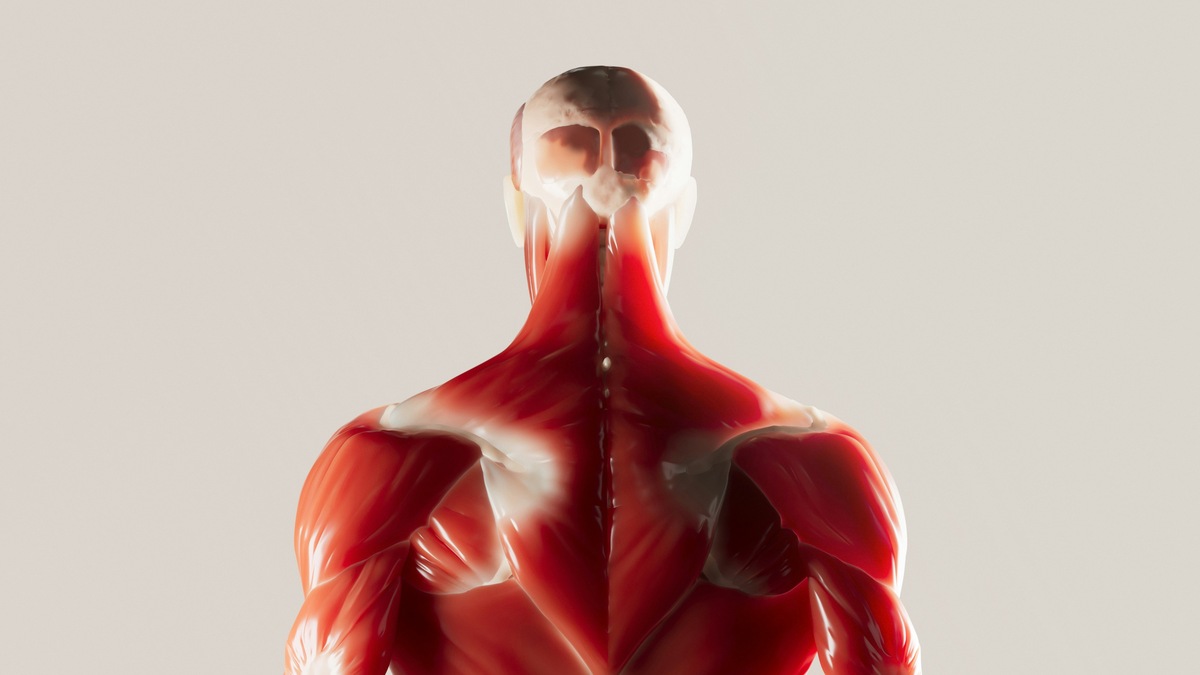This article is for informational purposes only and does not constitute medical advice. Always consult with a qualified healthcare provider before considering any peptide therapy.
Oxytocin, often referred to as the “love hormone,” is becoming a notable peptide therapy for men’s health. This peptide hormone, which is made up of nine amino acids and produced in the hypothalamus, does much more than just support social bonding.
Research indicates that oxytocin plays a significant role in stress management, sexual function, metabolic processes, and heart health in men.
Quick Takeaways
- Oxytocin administration can increase trust and generosity in men by up to 80%, according to controlled studies
- The standard research dose is 24 IU intranasal, with behavioral effects typically appearing 20-90 minutes after administration
- Clinical trials involving over 1,500 participants found no significant difference in side effects between oxytocin and placebo groups
- Men with benign prostatic hyperplasia (BPH) should exercise caution, as research links elevated oxytocin to prostatic cell proliferation
What is Oxytocin?
Oxytocin is a hormone and neuropeptide made in the supraoptic nucleus and paraventricular nucleus of the hypothalamus. After it is produced, the pituitary gland releases it into the brain and bloodstream. This release affects many physiological systems.
The peptide works by binding to G-protein-coupled oxytocin receptors (OT-R) found throughout the brain and body. These receptors are located in areas like the amygdala, nucleus accumbens, and ventral tegmental area, which are responsible for emotion, reward, and social behavior.
How Does Oxytocin Work in Men?
Oxytocin modulates neural circuits by affecting the excitatory/inhibitory balance. Oxytocin-producing cells in the hypothalamus project onto GABAergic inhibitory interneurons in the central amygdala, which then decrease output to the brainstem. This pathway reduces fear behaviors and explains oxytocin’s anxiolytic properties[1].
The peptide also attenuates the stress axis by inhibiting corticotropin-releasing hormone (CRH) release from parvocellular neurons. This suppressive modulation of the hypothalamic-pituitary-adrenal (HPA) axis underlies many of oxytocin’s stress-reducing effects[2].
How is Oxytocin Released in Males?
Research demonstrates that the release of oxytocin follows a pulsatile pattern in healthy men at rest. Men with lower oxytocin pulse height and pulse mass show more avoidant attachment styles and greater difficulty identifying feelings, suggesting low oxytocin levels may impact emotional regulation[3].
Plasma oxytocin levels increase markedly after ejaculation. The spinal cord contains higher local concentrations of oxytocin in males compared to females, suggesting sex-specific roles in male reproductive function[4].
What Are the Research-Backed Benefits of Oxytocin for Men?

The scientific literature reveals several areas where oxytocin supplementation shows promise for male health and behavior.
Can Oxytocin Improve Relationship Bonding and Fidelity?
One of the most compelling findings involves oxytocin’s role in promoting monogamous behavior and emotional connection. In a landmark study by Dr. René Hurlemann at the University of Bonn, men in committed relationships who received intranasal oxytocin (24 IU) maintained approximately 28-30 inches distance from an attractive unfamiliar woman, compared to 20-24 inches for single men or those receiving placebo[5].
Dr. Hurlemann stated: “Previous animal research in prairie voles identified oxytocin as major key for monogamous fidelity in animals. Here, we provide the first evidence that oxytocin may have a similar role for humans.”
Research published in PNAS showed that oxytocin enhances brain reward system responses when men view their female partner’s face, increasing activation in the nucleus accumbens compared to viewing unfamiliar women. This suggests oxytocin contributes to romantic bonds by making partners appear more attractive and rewarding[6].
Does Oxytocin Increase Trust and Generosity?
Dr. Paul Zak of Claremont Graduate University pioneered research showing oxytocin’s effects on trust and prosocial behavior. His studies demonstrated:
- Participants given oxytocin showed 80% more generosity in monetary decisions compared to placebo[7]
- Oxytocin more than doubled the number of people willing to send all their money to a stranger in trust experiments
- Donations to charity increased by 50% following oxytocin administration[8]
Dr. Zak noted: “We found that those who received oxytocin donated, on average, 56 percent more money to charity compared with participants who received the placebo. Oxytocin is responsible for virtuous behaviors, working as the brain’s ‘moral molecule.'”[8]
What Effects Does Oxytocin Have on Male Sexual Function?
The role of oxytocin in male reproductive health extends beyond bonding to direct sexual function. Oxytocin plays roles in male sexual activity through the spinal ejaculation generator (SEG). Research published in 2021 found that systemic oxytocin administration significantly shortened the latency to first mount, intromission, and ejaculation in male rats[4].
The study concluded: “Oxytocin influences male sexual activity via the SEG. In men, it is suggested that an increased oxytocin level in the circulation influences libido, penile reflexes, and orgasm.”
A 2025 study in the Journal of Sexual Medicine demonstrated that intranasal oxytocin improved sexual behavior in sexually inactive male rats, with significant decreases in mount and intromission latencies. The researchers proposed a “dual-action mechanism” whereby oxytocin enhances both central sexual motivation and peripheral androgen synthesis[9].
Human clinical translation has been less consistent. Despite robust animal evidence, human studies using intranasal oxytocin have not consistently confirmed facilitatory effects on sexual behavior. Those interested in peptides for men’s health should note these mixed results.
Third-Party Tested, 99% Purity
Order lab-verified Oxytocin from our top recommended vendor.

Can Oxytocin Reduce Stress and Anxiety in Men?
A body of research demonstrates oxytocin’s ability to buffer stress and anxiety. Dr. Markus Heinrichs and colleagues at the University of Freiburg showed that men receiving both oxytocin and social support showed the strongest reduction in cortisol response to psychosocial stress[10].
The researchers stated: “On the basis of the findings that oxytocin administration, in particular when combined with social support, reduces the neuroendocrine and subjective stress response…”
The release of oxytocin from the paraventricular nucleus exerts an inhibitory effect on CRH release by down-regulating gene expression. This mechanism directly addresses the physiological roots of stress and anxiety, suppressing the entire stress axis cascade.
Does Oxytocin Support Weight Management and Metabolism?
Research led by Dr. Elizabeth Lawson at Harvard Medical School/Massachusetts General Hospital revealed oxytocin’s effects on eating behavior. A study of 25 healthy men found that intranasal oxytocin administration resulted in reduced snack consumption, particularly chocolate cookies by 25%[11].
The study also found attenuated cortisol and ACTH levels (basal and postprandial) and improved insulin sensitivity following meals. Dr. Lawson stated: “Our results are really exciting. Oxytocin might be a promising treatment for obesity and its metabolic complications.”
A recent randomized controlled trial found that 8-week intranasal oxytocin treatment did not result in significant weight loss in adults with obesity, though quality of life improvements were observed[12]. For those researching best peptides for weight loss, this nuanced finding warrants attention.
Dr. Lawson noted: “I don’t think that we should close the door on oxytocin therapeutics in obesity management based on our trial. We should explore different ways to increase oxytocin signaling, including alternative dosing regimens, drug formulations, and oxytocin receptor agonists.”
What Cardiovascular Benefits Does Oxytocin Offer?
Animal research suggests oxytocin may offer cardioprotective effects. A 2024 rat study demonstrated that oxytocin treatment in heart failure models resulted in higher ejection fraction (66.71% vs. 25.83%), improved cardiac output (62.4 vs. 20.35), and greater stroke volume (180.2 vs. 73.96)[13].
Oxytocin may exert cardioprotective effects through inhibition of atherosclerosis, reduction of inflammatory cytokines, and stimulation of endothelial regeneration[14].
Recommended Oxytocin Dosages for Men
Human intranasal oxytocin studies primarily employ dosages between 20-48 IU, with 24 IU being the most common.
Intranasal Oxytocin Dosing
Research examining optimal intranasal dosing provides the following insights[15]:
| Dose | Research Finding |
|---|---|
| 8 IU | Most efficacious for eliciting amygdala response to emotional faces in one study |
| 24 IU | Standard research dose; elicited most robust amygdala decreases within 45-70 min window |
| >21 IU/day | More effective than ≤21 IU/day in autism trials |
| 32 IU/day | High-dose protocol showing improvements in male ASD participants |
| 48 IU | Higher doses may be necessary for empathic response enhancement |
Subcutaneous Injection Protocol
For subcutaneous administration, peptide protocols typically suggest:
- Starting dose: 100 mcg (3 units) once daily
- Maximum dose: 200 mcg (6 units) daily
- Cycle length: 8 weeks on, 4 weeks washout
- Reconstitution: Mix with 3 mL bacteriostatic water
When Should You Take Oxytocin?
Behavioral and neural effects are typically examined 20-90 minutes post-administration. One study showed CSF concentrations of oxytocin took up to 75 minutes to peak after intranasal administration, while plasma concentrations peaked at 15 minutes[16].
| Application | Recommended Dose | Route |
|---|---|---|
| Stress relief | 10-20 mcg | Intranasal/subcutaneous |
| Social bonding/trust | 24 IU | Intranasal |
| Metabolic studies | 24-40 IU | Intranasal |
| Chronic pain | 20-40 mcg | Subcutaneous |
Those looking at peptides for pain management may find the chronic pain dosing protocols relevant, though more research is needed in this area.
Side Effects of Oxytocin in Males
Safety data from controlled trials provides reassurance about oxytocin’s tolerability profile.
A comprehensive review of 38 controlled trials involving 1,529 participants found that side effects did not differ significantly between oxytocin and placebo groups. Participants were generally unable to determine whether they had received oxytocin or placebo[17].
A randomized controlled trial specifically evaluating 4 weeks of intranasal oxytocin (24 IU twice daily) in healthy older men (n=95) found[18]:
- No significant impact on cardiovascular measures
- No changes in urine osmolality or serum metabolic biomarkers
- Adverse events were generally mild and comparable between groups
- Oxytocin did not significantly increase the likelihood of reporting adverse events
The most frequently reported side effects include:
- Nasal irritation, dry mouth, or throat discomfort
- Headaches and dizziness (usually mild to moderate)
- Drowsiness or lightheadedness
- Increased thirst and urination
- Heightened emotional sensitivity
- Nausea (infrequent)
Serious Safety Concerns and Contraindications
While generally well-tolerated in research settings, several concerns warrant attention.
At high doses or with IV administration, oxytocin can cause cardiac arrhythmias, blood pressure changes, and rarely myocardial ischemia. Prolonged high-dose use can cause hyponatremia due to oxytocin’s antidiuretic properties, potentially leading to confusion, seizures, or altered consciousness.
Research indicates oxytocin is highly expressed in serum and prostate tissue of men with benign prostatic hyperplasia (BPH), and exogenous oxytocin may aggravate prostatic cell proliferation. The study concluded: “Oxytocin is highly expressed in the serum and prostate tissue of patients with BPH. In addition, oxytocin aggravates BPH and the oxytocin-induced proliferative effect on prostatic cells is mediated through the MEK/ERK/RSK pathway.”[19]
Who Should Avoid Oxytocin?
Contraindications include:
- History of cardiovascular conditions, especially arrhythmias
- Epilepsy or seizure disorders
- Kidney or liver dysfunction
- Known hypersensitivity to oxytocin
- Men with diagnosed or suspected BPH
Those interested in peptide therapy for testosterone should discuss potential interactions with their healthcare provider before combining therapies.
How Can You Naturally Boost Oxytocin Levels?
While supplementation offers one approach, several natural methods can help release oxytocin and support healthy levels.
Physical touch and social connection are among the most effective ways to boost oxytocin naturally. Activities like hugging, massage, and intimate contact trigger oxytocin release. Spending quality time with loved ones, engaging in meaningful conversations, and building strong social bonds all promote oxytocin production.
Exercise, particularly yoga and moderate-intensity activities, can increase oxytocin levels. Listening to music, practicing meditation, and even playing with pets have been shown to release oxytocin. Acts of kindness and generosity toward others also stimulate oxytocin production, creating a positive feedback loop that strengthens emotional connection.
For men concerned about low oxytocin levels, addressing lifestyle factors like chronic stress, poor sleep, and social isolation may help restore natural oxytocin balance before considering supplementation.
💡PEPTIDE PICKS: MORE TO EXPLORE
- Want to optimize your health as a man? Discover the top peptide therapies specifically designed for men’s wellness.
- Looking to slow down aging? Check out our comprehensive guide to the best anti-aging peptides backed by research.
- Struggling with sleep quality? Explore our roundup of peptides that can improve your sleep patterns.
What Do Experts Say About Oxytocin Research?
Despite promising initial findings, oxytocin research faces controversy regarding replicability and individual variation.
Are Study Results Replicable?
A 2022 critical analysis published in Philosophical Transactions of the Royal Society raised concerns: “The measurement studies are plagued by analytical problems and the questionable relevance of peripheral measurements to central activity. The translational clusters accept the evidence from intervention studies and are primarily concerned with the potential of oxytocin for treatments, but have produced little robust evidence of any efficacy.”[20]
Several key RMET (Reading the Mind in the Eyes Test) replication studies failed to reproduce initial positive findings, with some showing no effect of oxytocin on emotional recognition.
Does Individual Response Vary?
Effects of oxytocin appear highly dependent on:
- Genetic factors: OXTR gene polymorphisms (e.g., rs6791619, rs53576) significantly predict treatment response[21]
- Attachment style: Individuals with secure attachment may respond differently than those with avoidant patterns
- Social context: Oxytocin’s effects can be either positive or negative depending on the social environment
- Baseline anxiety: Nostril dominance and social phobia symptomatology influence response
A gap exists in understanding chronic oxytocin administration effects. Research notes: “The effectiveness of chronic oxytocin administration in humans needs to be studied further as adverse behavioral and cellular effects of chronic oxytocin treatment have been shown in rodents.”[22]
Those researching best peptides for brain function should consider the context-dependent nature of oxytocin’s cognitive effects.
The Bottom Line
Oxytocin peptide therapy for men shows promise in several areas, including enhanced partner bonding, stress reduction, improved social cognition, and possible metabolic improvements. The most established effects center on trust enhancement, partner attractiveness perception, and cortisol reduction when combined with social support.
Less established benefits include direct sexual function improvement in humans, long-term weight loss, and chronic pain management. Effects are context-dependent and vary by individual genetics and psychology. Men with prostate health concerns should monitor symptoms carefully. Long-term safety data remains limited, and oxytocin works not as a simple “love hormone” but as a complex modulator of social salience whose effects depend on context, genetics, and baseline psychological state.
Frequently Asked Questions
What happens if a man takes oxytocin?
When men take oxytocin, they may experience increased trust, enhanced partner bonding, reduced stress responses, and changes in social behavior. Clinical studies show these effects typically appear 20-90 minutes after administration and can last several hours.
Is oxytocin good for men?
Research suggests oxytocin offers benefits for stress management, relationship bonding, and potentially metabolic health in men. Safety profiles from over 1,500 study participants show good tolerability, though individual responses vary significantly based on genetics and social context.
Does oxytocin increase testosterone in males?
Current research does not show that oxytocin directly increases testosterone levels in men. Some studies suggest oxytocin may work alongside testosterone to influence social and reproductive behaviors, but the relationship is complex and context-dependent.
What are the side effects of oxytocin in males?
Most men tolerate oxytocin well, with common side effects including mild nasal irritation, headaches, and drowsiness. Men with benign prostatic hyperplasia should use caution, as research links elevated oxytocin to prostatic cell proliferation.
Can oxytocin make you fall in love?
While oxytocin is a hormone often called the “love hormone,” it doesn’t make you fall in love. Research shows it enhances existing romantic bonds by increasing the attractiveness of current partners and may help maintain monogamous behavior in committed relationships.
How long does intranasal oxytocin last?
Behavioral effects of intranasal oxytocin typically begin 20-30 minutes after administration and can last 2-4 hours. CSF concentrations peak at 75 minutes, while plasma levels peak earlier at 15 minutes.
References
- Fineberg SK, Ross DA. Oxytocin and the Social Brain. Elsevier BV; 2017. https://doi.org/10.1016/j.biopsych.2016.11.004
- Kuppusamy T. A short note on oxytocin and stress attenuation. Biomedical Informatics; 2021. https://doi.org/10.6026/97320630017921
- Baskaran C, Plessow F, Silva L, Asanza E, Marengi D, Eddy KT, et al. Oxytocin secretion is pulsatile in men and is related to social-emotional functioning. Elsevier BV; 2017. https://doi.org/10.1016/j.psyneuen.2017.07.486
- Oti T, Sakamoto T, Sakamoto H. Systemic effects of oxytocin on male sexual activity via the spinal ejaculation generator in rats. Informa UK Limited; 2021. https://doi.org/10.1080/19420889.2021.1902056
- Scheele D, Striepens N, Güntürkün O, Deutschländer S, Maier W, Kendrick KM, et al. Oxytocin Modulates Social Distance between Males and Females. Society for Neuroscience; 2012. https://doi.org/10.1523/jneurosci.2755-12.2012
- Scheele D, Wille A, Kendrick KM, Stoffel-Wagner B, Becker B, Güntürkün O, et al. Oxytocin enhances brain reward system responses in men viewing the face of their female partner. Proceedings of the National Academy of Sciences; 2013. https://doi.org/10.1073/pnas.1314190110
- Zak PJ, Stanton AA, Ahmadi S. Oxytocin Increases Generosity in Humans. Public Library of Science (PLoS); 2007. https://doi.org/10.1371/journal.pone.0001128
- Zak P. Why Inspiring Stories Make Us React: The Neuroscience of Narrative. Cerebrum. 2015;2015.
- Enomoto C, Oti T, Yamanaka T, Shimada M, Sakamoto H. Dual-action intranasal oxytocin enhances both male sexual performance and fertility in rats. Oxford University Press (OUP); 2025. https://doi.org/10.1093/jsxmed/qdaf228
- Heinrichs M, von Dawans B, Domes G. Oxytocin, vasopressin, and human social behavior. Elsevier BV; 2009. https://doi.org/10.1016/j.yfrne.2009.05.005
- Lawson EA, Marengi DA, DeSanti RL, Holmes TM, Schoenfeld DA, Tolley CJ. Oxytocin reduces caloric intake in men. Wiley; 2015. https://doi.org/10.1002/oby.21069
- Plessow F, Kerem L, Wronski ML, Asanza E, O’Donoghue ML, Stanford FC, et al. Intranasal Oxytocin for Obesity. Massachusetts Medical Society; 2024. https://doi.org/10.1056/evidoa2300349
- Althammer F, Roy RK, Kirchner MK, Lira EC, Schimmer S, Charlet A, et al. Impaired oxytocin signaling in the central amygdala in rats with chronic heart failure. Cold Spring Harbor Laboratory; 2023. https://doi.org/10.1101/2023.11.22.568271
- Aulinas A, Lawson EA. The Oxytocin System and Implications for Oxytocin Deficiency in Hypothalamic-Pituitary Disease. The Endocrine Society; 2025. https://doi.org/10.1210/endrev/bnaf008
- Quintana DS, Lischke A, Grace S, Scheele D, Ma Y, Becker B. Advances in the field of intranasal oxytocin research: lessons learned and future directions for clinical research. Springer Science and Business Media LLC; 2020. https://doi.org/10.1038/s41380-020-00864-7
- Striepens N, Kendrick KM, Hanking V, Landgraf R, Wüllner U, Maier W, et al. Elevated cerebrospinal fluid and blood concentrations of oxytocin following its intranasal administration in humans. Springer Science and Business Media LLC; 2013. https://doi.org/10.1038/srep03440
- MacDonald E, Dadds MR, Brennan JL, Williams K, Levy F, Cauchi AJ. A review of safety, side-effects and subjective reactions to intranasal oxytocin in human research. Elsevier BV; 2011. https://doi.org/10.1016/j.psyneuen.2011.02.015
- Rung JM, Horta M, Tammi EM, Perez E, Ojeda MC, Lin T, et al. Safety and tolerability of chronic intranasal oxytocin in older men: results from a randomized controlled trial. Springer Science and Business Media LLC; 2021. https://doi.org/10.1007/s00213-021-05862-3
- Xu H, Fu S, Chen Y, Chen Q, Gu M, Liu C, et al. Oxytocin: its role in benign prostatic hyperplasia via the ERK pathway. Portland Press Ltd.; 2017. https://doi.org/10.1042/cs20170030
- Leng G, Leng RI, Ludwig M. Oxytocin—a social peptide? Deconstructing the evidence. The Royal Society; 2022. https://doi.org/10.1098/rstb.2021.0055
- Kosaka H, Okamoto Y, Munesue T, Yamasue H, Inohara K, Fujioka T, et al. Oxytocin efficacy is modulated by dosage and oxytocin receptor genotype in young adults with high-functioning autism: a 24-week randomized clinical trial. Springer Science and Business Media LLC; 2016. https://doi.org/10.1038/tp.2016.152
- Tabak BA, Leng G, Szeto A, Parker KJ, Verbalis JG, Ziegler TE, et al. Advances in human oxytocin measurement: challenges and proposed solutions. Springer Science and Business Media LLC; 2022. https://doi.org/10.1038/s41380-022-01719-z







